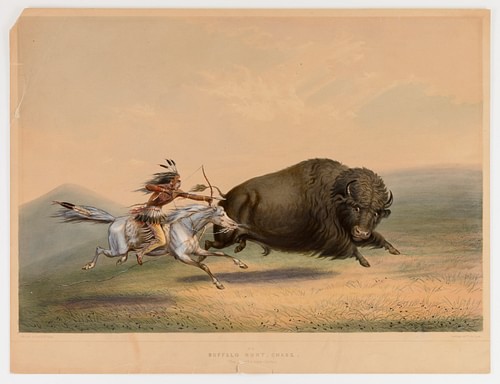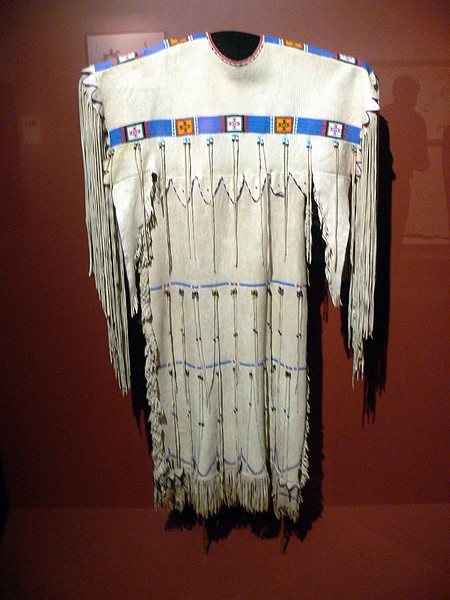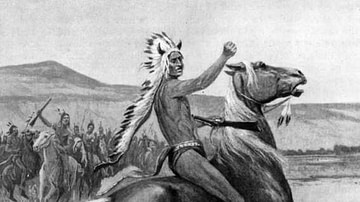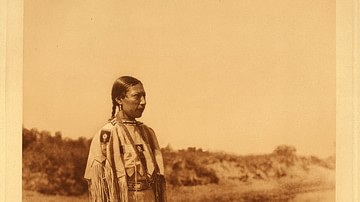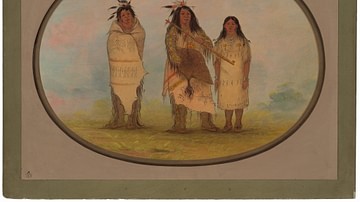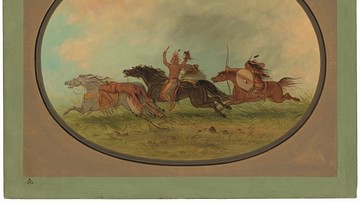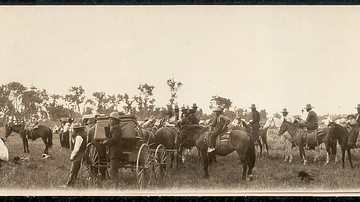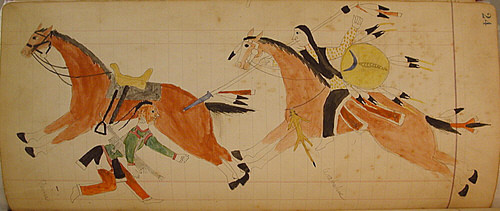
The Cheyenne are a North American Native nation, originally from the Great Lakes region, who migrated to modern-day Minnesota and then to areas in North Dakota and further southwest. They are associated with the Plains Indians culture and, after mastering the horse, became one of the most powerful nations of the American West.
Initially hunter-gatherers, the Cheyenne adopted agriculture and lived in permanent dwellings, raising crops that included wild rice. Some of the Cheyenne's defining characteristics are given by scholar Michael G. Johnson:
[By c. 1680] they lived in fixed villages, practiced agriculture, and made pottery, but lost these arts after being driven out onto the Plains to become nomadic bison hunters. They became one of the focal points of the Plains culture, characterized by tipi dwelling, development of age-graded male societies, geometrical art, and the development of the ceremonial world renewal complex, the Sun Dance. (118)
After their migration from the Great Lakes region, caused by the influx of other Native peoples into the area, they abandoned permanent settlements for a nomadic lifestyle, adopted the teepee (tipi) as housing, and followed the buffalo, which, like with other Plains Indians nations, was their primary food source. At first, they used dogs as pack animals to move their villages, but, after they mastered the horse in the 17th century, horses became their central mode of transportation as well as a status symbol of wealth and power.
They spoke (and still speak) the Cheyenne language which belongs to the Algonquian language group and allied themselves with the Arapaho, another Algonquian-speaking nation, in the early 19th century. The Cheyenne and Arapaho have continued their relationship up through the present day.
They hold to an animistic religious belief that all life is sacred, imbued with a spirit, and interconnected. Religious rituals include the Sun Dance, which is said to have been given to them by their great prophet Sweet Medicine, who also instituted formal government, societal structure, and the original four military societies that would become increasingly important in the wars of the 19th century fought against Euro-American expansion across their lands and the genocidal policies of the US government.
Conflicts with the US Army, the mass slaughter of the buffalo by white hunters to eliminate their food source, and the introduction of European diseases greatly reduced the number of Cheyenne throughout the 19th century, during which they were forced onto reservations as more of their land was taken by white settlers. Today the majority of the Northern Cheyenne live on the reservation in Montana while most of the Southern Cheyenne live on the reservations in Oklahoma.
Name & Nation
The name they are most commonly known by was given by the Sioux. Scholar Adele Nozedar comments:
The name Cheyenne was, for a while, believed to be derived from the French word for "dog" which is chien, since this people had a noted society of Dog Soldiers. However, the name is actually a Sioux word meaning "people of different speech." The Cheyenne name for themselves, Tsistsistas, means "beautiful people." (93)
The meaning of Tsistsistas has actually been translated in several ways, including "the people", "like-minded people", and "like-hearted people." They called their homelands Tsiihistano, meaning "home of the people," which, at the height of Cheyenne power, stretched from Montana to Texas and their economy depended on the great herds of bison, which they hunted across these lands seasonally.
The Cheyenne nation, originally of three groups, expanded to ten prior to the 19th century, including:
- Heviqs-nipahis
- Hevhaitanio
- Masikota
- Omisis
- Sutaio
- Wotapio
- Oivimana
- Hisiometanio
- Ogtoguna
- Honowa
These ten make up "the people" of the Cheyenne nation, who are represented by delegates to the governing body known as the Council of Forty-Four, but there are other bands who are also considered Cheyenne. Further, the nation is divided into the people known as Northern Cheyenne and Southern Cheyenne.
Government & Daily Life
They developed a representational government, the Council of Forty-Four, which is responsible for decisions affecting the entire nation. The council, comprised of four chiefs from each of the ten tribes plus four elder statesmen who had previously served, are not elected but chosen by the council members based on their personal qualities of leadership and wisdom. Chiefs serve for a period of ten years and usually choose their successors.
Each chief of a band is responsible for governing his own people and making decisions regarding them. The Council of Forty-Four, as noted, only deals with nation-wide policies. The council also has nothing to do with military actions or religious ceremonies, which are the responsibility of the military societies.
The Cheyenne military societies acted as the "police force" but were also responsible for the ethical conduct of the people and enforcing the principles that guided such behavior. The original four societies were:
- Bowstring Men
- Fox Warriors Society
- Elk Warriors Society
- Shield Warriors Society
These four are said to have been established by the prophet Sweet Medicine who also founded the Council of Forty-Four. The two other societies, the Dog Warrior Society and the Contrary Warriors Society, were formed after Sweet Medicine had left the people and sent a prophetic dream to the elders that these two were necessary. The Dog Warrior Society, also known as the Dog Soldiers and Dog Men, became the best-known of the military societies and the most powerful political force among the Cheyenne in the latter part of the 19th century.
In the early 20th century, it was thought there was a seventh society of warrior women, but this claim has been challenged. Female Cheyenne warriors such as Buffalo Calf Road Woman (l. c. 1844-1879), Ehyophsta (d. 1915), and Mochi (l. c. 1841-1881) all fought alongside their husbands in the same groups as men. According to Cheyenne history, Buffalo Calf Road Woman struck the blow that knocked Lt. Colonel George Armstrong Custer (l. 1839-1876) from his horse at the Battle of the Little Bighorn (25-26 June 1876), resulting in his famous "last stand" on foot.
After their migration to the Great Plains, the Cheyenne followed the buffalo but also hunted bear, deer, elk, turkey, and small game. Men were either hunters or warriors while women were responsible for setting up and taking down the tipi, keeping the home, raising the children, foraging for herbs, wild vegetables, berries, and nuts, making clothing and footwear, preparing meals, and engaging in trade with other nations and, eventually, white settlers. Cheyenne regularly traded clothing, blankets, leather goods, tobacco, and various items made from the carcass of the buffalo (including pemmican, dried buffalo meat) for guns, ammunition, iron weapons, tools, and other necessities, including horses.
As with other Native American nations, women raised the children of both sexes until a certain age, usually around eight, when male children were taught to hunt and fight by their fathers and male relatives. Girls continued under the tutelage of their mothers, grandmothers, and extended female relatives in traditionally understood tasks and responsibilities.
Religion, Afterlife, & Ritual
The Cheyenne are a deeply spiritual people adhering to a religious belief system now known as animism which holds that all things are imbued with a spirit, animate or inanimate, and should be respected accordingly. Their central deity is the Wise One Above (Maheo/Ma'heo'o), giver of all good gifts, but there are several other deities including one who is said to live on earth or under the ground and the Four Spirits of the cardinal points of the compass.
The sacred artifacts of the Cheyenne are the Four Arrows (two for war, two for success in hunting) and the Sacred Buffalo Hat, kept in a sacred bundle along with a ceremonial pipe (similar to the Sioux ceremonial pipe). The Four Arrows were given to the people by the prophet Sweet Medicine, who received them from the spirit world in the sacred cave at Bear Butte Mountain. The Sacred Buffalo Hat was given by their other great prophet, Erect Horns, who also encouraged their nomadic lifestyle and relationship with the buffalo. According to Nozedar, the Four Arrows and Sacred Buffalo Hat, with the other items of the sacred bundle, "symbolize the actual existence and soul of the Cheyenne Nation itself" (463).
In Cheyenne belief, Maheo breathes the breath of life into one at birth at the same time the soul enters the body. The breath of life animates the body, but the soul is distinct. The life one lives shapes, colors, and animates the soul. At death, the soul of a person who has lived and, most importantly, died well – of natural causes after a life lived in service to the community, in battle, or in childbirth – leaves the body and walks lightly the long fork of the Milky Way to the community of the dead, where one is rewarded with continued existence in an eternal camp. If one lived selfishly and meanly, dying as an outcast or by suicide, then the soul at death treads the short fork of the Milky Way to darkness and, in their anger at this final destination, could sometimes return to earth as ghosts to torment the living or trick them into some thought or behavioral pattern that would damn them to the path of the short fork as well.
The most important ritual observed is the Sun Dance, but there is also the Animal Dance (performed to honor the buffalo, primarily), the Renewal of the Four Arrows ritual, and the Renewal of the Sacred Buffalo Hat ceremony. As the Four Arrows and Sacred Buffalo Hat are understood as spiritually alive, they require renewal in the same way the earth, people, and animals do through enacting the Sun Dance and Animal Dance.

The will of the gods, the nature of spirits, threats posed by ghosts, the deeds of great heroes, the peoples' history, and how the world worked were all transmitted to the community through stories. Among the most popular was (and still is) Falling Star, detailing the birth and adventures of the hero Hotoketana'ohtse ("Falling Star"), the savior who delivered his people from various threats and saved them from starvation. Other stories dealt with figures such as Erect Horns and Sweet Medicine, who gave the people their sacred artifacts, judicial system, government, societal structure, and laws.
The central law handed down by Sweet Medicine was that no Cheyenne should ever kill another, and this translated to a wider application of refraining from killing anyone. Cheyenne warrior culture was initially wholly focused on defense, on the protection of the community, but, as threats to their existence became more serious and persistent, Cheyenne warriors took the fight to others in preemptive strikes.
The Horse & Warfare
Once the Cheyenne had the horse, they, like other Plains Indians nations, expanded their hunting territory and altered the tactics of their military. The mounted warrior could travel faster and farther than the foot soldier could previously, encouraging the Cheyenne to engage in preemptive measures instead of waiting for an enemy to arrive at their villages. Raids were also undertaken against other nations – including, but not limited to, the Arikara, Crow, Blackfeet, Pawnee, and, at first, the Sioux – for horses and supplies. The military societies would each assume responsibility in turn for a given raid or military campaign, often engaging in rivalry which then became the basis for later stories of great exploits.
In keeping with the directive against needless killing, Cheyenne warriors frequently engaged in the practice of counting coup, in which combatants touched or struck an enemy with a coup stick (a wooden rod, sometimes curved at one end), a knife, bow, lance, or one's hand) but did not kill them. Once one was touched in this way in battle, one was shamed and might leave the field. The Cheyenne, like the Sioux and others, considered it a greater honor to count coup on an opponent than to kill him.
War with the US Government
Although military traditions like counting coup continued after the Plains Indians encountered white settlers and the US Army, it became increasingly clear, between 1825 and 1851, that the new arrivals not only intended to take the ancestral lands of the Cheyenne but also wanted to regulate how they lived in peace or waged war. The treaties of 1825 set guidelines for how the Cheyenne were to engage in trade and interact with other Native American nations.
The establishment of Bent's Fort on the upper Arkansas River in Colorado in 1832, to protect an influx of settlers, deprived the Cheyenne of hunting grounds and other resources, leading to the nation dividing into the Northern Cheyenne and Southern Cheyenne, who moved to different locations just to survive. The Fort Laramie Treaty of 1851 recognized the tribal right of occupancy of the land, not ownership, and allocated each nation a certain territory. Nations were supposed to have been compensated for the loss of land, but, as with many if not all treaties after 1851, this did not materialize.
Skirmishes with settlers, and the cholera outbreak of 1849, had already reduced the Cheyenne population, but wars in defense of their lands between 1854 and 1879, as well as forced relocation, decreased the population further. Whenever it suited the US government to break the promises made in the treaties, they did so, as in 1859 with the Colorado Gold Rush, when suddenly the treaty with the Cheyenne was tossed aside in favor of the interests of white settlers. The loss of land and resources left the Cheyenne and Arapaho facing starvation and led to the Cheyenne Uprising of 1863, during which war parties organized by the Cheyenne military societies attacked white settlements, killing civilians and burning their crops.
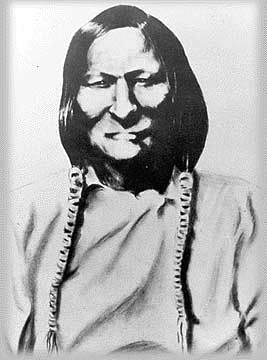
Chief Black Kettle (l. c. 1803-1868) and others continually sought peace with the US government, but their hopes were regularly betrayed, as at the Sand Creek Massacre of 29 November 1864 when roughly 150 Arapaho and Cheyenne, flying the American flag and the white flag, were slaughtered by a cavalry contingent under John Chivington. Most of the dead were the elderly, women, and children. The Sand Creek Massacre shifted power from the Council of Forty-Four, who had advocated for peace and concessions to the US government, to the Dog Soldiers who had argued for resistance and war.
Black Kettle and his followers continued to work for peaceful coexistence while the faction that followed the Dog Soldiers and the great warrior Roman Nose (also known as Hook Nose, l. c. 1830 -1868), supported by Arapaho allies, resisted. On 27 November 1868, Lt. Col. George A. Custer led his troops against Black Kettle's camp at the Battle of Washita River, killing over 100 people who had been led to believe they were engaged in peaceful negotiations, including Black Kettle and his wife. This massacre encouraged further resistance by the Dog Soldiers led by Chief Tall Bull (l. 1830-1869) until their defeat, and Tall Bull's death, at the Battle of Summit Springs on 11 July 1869.
Continued land theft, lies, and slaughter led the Cheyenne and Arapaho to join the Sioux in major resistance, defeating the US Army and killing Custer at the Battle of the Little Bighorn in 1876. US retaliation was swift, breaking the Cheyenne – who by this time had lost many of their most powerful leaders – and forcing them to relocate to the region of "Indian Territory", modern Oklahoma. More Cheyenne died on the march south and even more once they arrived at the reservation which could not support them.
In 1878, the chiefs Morning Star (better known as Dull Knife, l. c. 1810-1883) and Little Wolf (also known as Little Coyote, l. c. 1820-1904) led their people back toward their ancestral homes in what has come to be known as the Northern Cheyenne Exodus (dramatized in the 1964 John Ford film, Cheyenne Autumn). The Northern Cheyenne and Arapaho were forced onto a reservation in Montana, while the Southern Cheyenne and Arapaho remained on the reservations of Oklahoma.
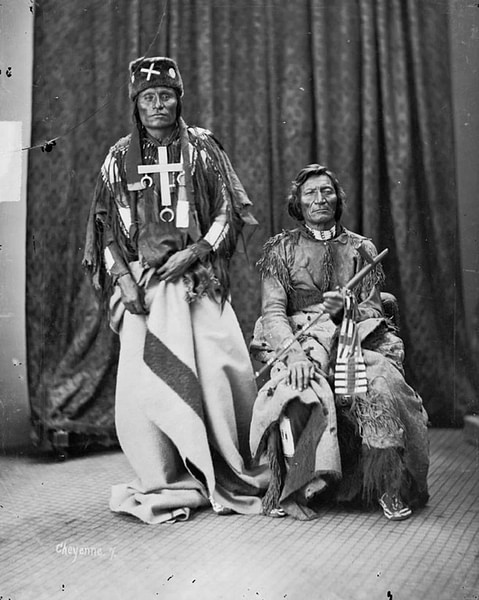
Conclusion
Today, the majority of Cheyenne and Arapaho continue to live on these reservations, where, though faced with many challenges, they continue to honor their heritage and work to keep their culture, language, and religion alive. The Cheyenne and Arapaho Culture Program works to preserve the heritage of the people while also instructing non-Natives on Cheyenne/Arapaho cultural legacy. This program also sponsors The Sand Creek Massacre Representatives, who ensure the history of the event is remembered and presented accurately. Although the US government promised monetary compensation for the 1864 massacre, it was never paid and, as of 2023, still has not been paid.
The Cheyenne and Arapaho Language Program works to preserve the languages of both peoples and teach it to others in person and online. The Cheyenne and Arapaho operate six Lucky Star casinos throughout Oklahoma, boosting the economy and promoting the peoples' heritage. Today, there are a little over 10,000 Cheyenne living on the reservations in Montana and Oklahoma, still observing the same form of government as they once did, maintaining the same military societies, and preserving their history and culture through the stories of the past, just as their ancestors did.
